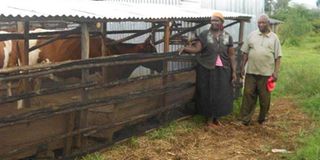Your cow should sleep under a net

Mr Daniel arap Sang and his wife at their farm in Nakuru. They use the Zerofly nets to protect their cows from biting insects. FILE PHOTO |
What you need to know:
- Protecting your animals from flies and other biting insects increases their productivity.
We are used to sleeping under bed nets to protect ourselves from the bites of mosquitoes, which cause malaria.
But did you know that your cows also need to sleep in nets to protect themselves from the nagana disease?
However, unlike our bed nets, cow nets are placed vertically one and-a-half metres high.
Previously the preserve of large commercial farms, cow nets are now finding their way into smaller farms.
The nets are treated with deltamethrin insecticide. Their main aim is to trap flies as they try to enter the cow pens.
Tsetse flies and other biting flies do not fly one and-a-half metres above the ground. They are blocked from reaching the cows by the nets and die within a short while.
The nets are also installed around manure pits to reduce flies migrating from the cow dung to the animal pens, hence reducing cases of mastitis.
REDUCE PRODUCTIVITY
According to Kenya Tsetse and Trypanosomiasis Eradication Council (Kenttec), biting pests can reduce a cow’s productivity by between 30 to 40 per cent.
The council has declared tsetse flies a major impediment to increased milk production.
Milk records of small scale farmers using the nets confirm increased production as well as reduction in veterinary costs due to the disappearance of disease causing flies.
Mrs Lucy Mburu Wanjatha is one such farmer. Sandwiched between several dairy farms in the lucrative dairy belt of Githunguri in Kiambu County, Wanjatha’s farm has maintained a constant production of 260 litres of milk every day since she installed her first nets two years ago.
On the three quarters of an acre of land, Wanjatha’s 13 dairy cows, were producing 200 litres of milk before she started using the nets.
The nets are treated with the deltamethrin insecticide, which kills the tsetse flies.
SIMPLE TECHNOLOGY
According to Mr Dominic Simba, a livestock department officer in Kisii, the prevalence of mastitis has dropped in areas where farmers are using nets.
The treated nets are a simple technology that protects cows from bites from flies which causes nagana. The flies also cause discomfort to the animals thus destabilizing the milk production.
According to Kenya Tse tse and Trypanosomiasis Eradication Council (Kenttec), biting flies reduce a cow’s production by between 30-40 per cent. They say a disturbed animal produces adrenaline when it is bitten, or it could knock down the milking can.
Joseah Kogo, a manager at Corporate Business Forms Ltd, which distributes the ZeroFly brand, said demand for the nets was outweighing their supply.
Mr Kogo said a typical zero grazing unit of 6 to 12 cows will need 30 to 50 metres of the net. “At Sh250 per metre, this comes to about Sh7,500 to Sh12,500. This is about Sh1,200 per cow per year,” he said.
Kogo spoke even as a government agency has raised the red flag over the need for counties to scale up fight against tsetse and trypanosomiasis problem in Kenya.
According to the Kenya Tsetse and Trypanosomiasis Eradication Council (KENTTEC), only Nairobi, Kiambu, Nyandarua, Nyeri, Nandi, Kisii, Uasin Gishu, Kericho, Nyamira and Trans Nzoia counties are free of the dangerous pest. These counties are still at risk of infestation due to climate change, which can easily convert them into tsetse habitat.
The KENTTEC chief executive Dr Pamela Olet said all the other counties infested find it hard to rear exotic dairy breeds which are susceptible to deadly disease spread by tsetse flies.
“This is one of the neglected tropical diseases. Areas adjacent to National parks are worst hit because parks act as a natural habitat for the pest while wildlife act as reservoirs for the disease causing protozoa – the trypanosome,” said Dr Olet.




